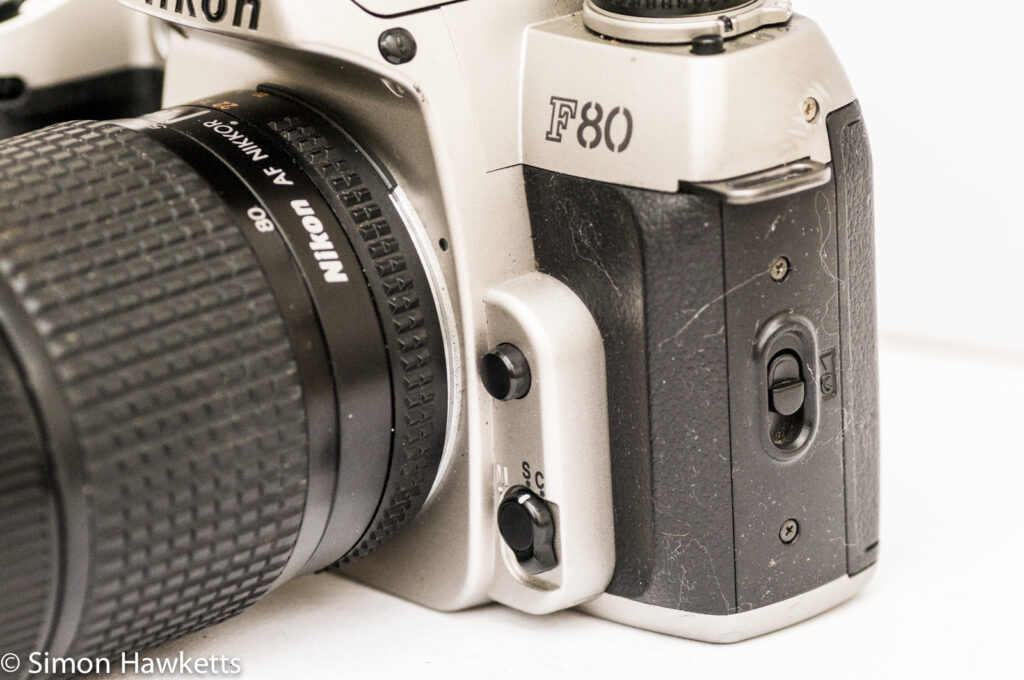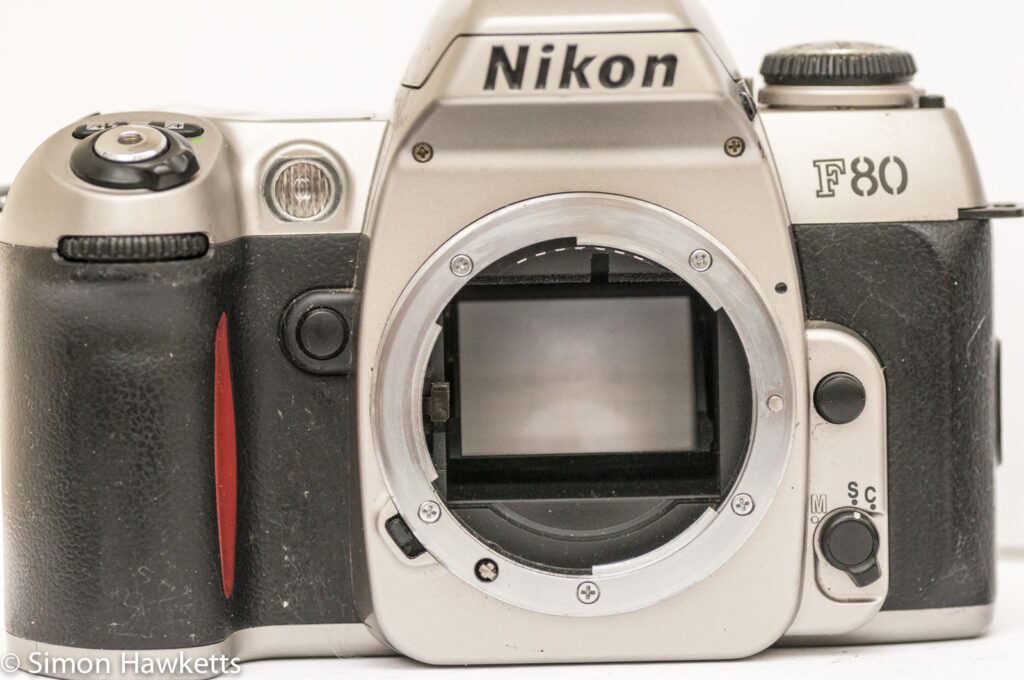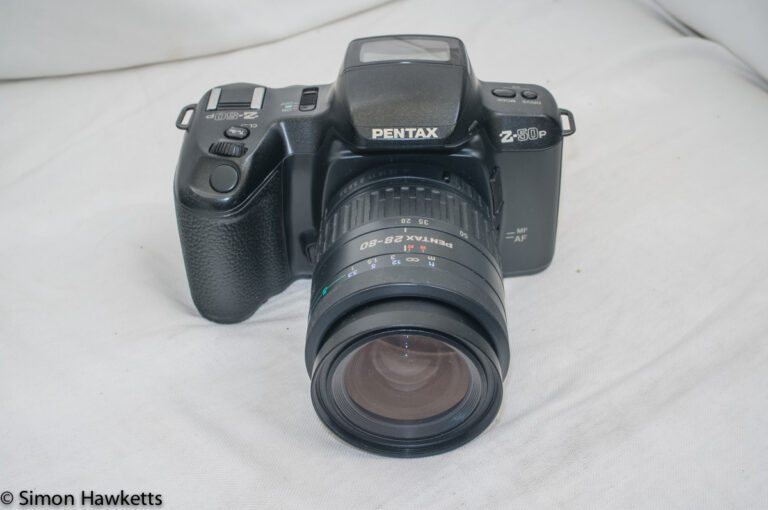Nikon F80 35 mm autofocus SLR camera
The Nikon F80 is a new addition to my vintage camera collection, but it’s one with a difference – it’s a camera I intend to use regularly.
Nikon F80 Images









My Nikon F80 camera
I’ve been thinking for a while about getting a good 35 mm autofocus camera (sounds a bit silly coming from someone who owns about 60 35 mm cameras!) which I could take with me when I go anywhere to shoot with my NEX 6 or Pentax K5.
Although I’m not someone who thinks that 35 mm film is automatically ‘better’ or ‘worse’ than digital, I’ve been looking at a lot of film pictures on Flickr and 500px lately, and I’m beginning to feel that having a film camera with you when you are taking pictures gives you another option and the possibility of another dimension to your photography.
Because I own a Pentax K5 DSLR, the obvious choice for a 35 mm camera to carry about would be a Pentax, and with that in mind I recently bought an MZ-50 and an MZ-30 from eBay.
The good thing about the Pentax MZ series is the cost. I got both the MZ-50 and the MZ-30 for only about £20 combined but, although they are nice cameras, they seem quite flimsy compared to the K5. I thought the flimsiness may be because the MZ-50 and MZ-30 were entry level cameras, so I got an MZ-5n and an MZ-7 (again about £20) to see how they compared. However, both these turned out to be faulty (the MZ-5n since I unwrapped it and the MZ-7 within a couple of hours) so ultimately I am concerned more with their reliability than their flimsiness.
For that reason, I had a look at the various forums and classic camera sites to find a good ‘pro’ spec camera which I could get for not too much money. The obvious manufacturer for me other than Pentax would be Nikon because, although I’ve never owned a Nikon, it’s one of the two makes I coveted most as a teenager in the 1970s.
After a bit of research, the F80 seemed to stand out as being fairly light to carry but with an impressive spec. (I could also have gone for the F100, which would have been a bit more robust, but the cost was quite a bit more). A quick search on eBay found this copy which I managed to win for £34 and took delivery a couple of days later.
Nikon F80 Camera Description
The first thing that was obvious as I unpacked the camera was that it was sticky!
This has actually gone down a bit over the last couple of days since I’ve been handling the camera, but a bit of Internet research suggests this is a common problem with Nikon cameras of this vintage.
I don’t know if Nikon added any special coatings to their cameras or if the rubber has just aged, but it was very sticky initially. I’ve read reports from people who have cleaned the camera with IPA and say that completely removed the stickiness, so I may try that if it becomes a problem. All I tried was wiping the rubber with a very slightly damp cloth and along with using it that seems to have toned it down quite a lot.
The camera is mostly plastic in construction, which accounts for the fact that it’s quite light, although the lens mount is metal. The lens supplied is a standard, slow 28-80 mm f/3.5-5.6 zoom and is fitted with a plastic mount and is incredibly light. The control layout is very intuitive, and the only thing I needed to refer to the handbook for was the CSM (custom) setting on the mode switch to find out what each of the settings were for.
For general picture taking there are two control dials at the front and back of the camera in much the same way as a modern SLR would have, an exposure mode dial on the top left-hand side and a big informative illuminated LCD panel on the top right-hand side. The viewfinder also repeats a lot of the information shown on the top plate LCD, so from any angle the photographer can easily find out how the camera is set up.
My initial impressions of the camera are extremely positive. It has as many features as my Pentax K5 DSLR and seems a really sophisticated camera. Obviously the real test will come when I put some film in it, so I’m going to shoot a test film around town over the next week (as I did with my MZ-50) before I draw too many conclusions, but from the point of view of handling and easy of use it seems a winner.
Exposure modes
The Nikon F80 offers full Manual control, Aperture priority, Shutter priority and Program (fully automatic) exposure modes. The two control dials adjust the aperture and shutter speed according to the mode and always seem to adjust the same parameter – so the front dial adjusts the aperture in Aperture Priority or Manual mode, and the rear wheel adjusts the shutter speed in Shutter Priority or Manual mode.
In program mode, the rear dial acts as program shift. Any exposure compensation is easy to apply because the exposure compensation button is positioned just in behind the shutter release, so while composing the picture it’s easy to move the finger to press the button and turn the back control wheel to add compensation.
It is obvious that this camera was not aimed at the lower end of the market because there are none of the picture modes which the entry level SLR’s (and in fact DSLR’s) had.
Making adjustments is easy with the camera to the eye because all the data is shown in the viewfinder in the LCD screen underneath the viewfinder itself.
Metering Modes
There are 3 metering modes available with the Nikon F80.
- Matrix metering – measured over 10 individual zones
- Center weighted – with the central area marked in the viewfinder
- Spot metered – where the metered point coincides with the focus point
Selection of the metering mode to use is carried out with a small switch on the back of the camera near the viewfinder. I found this a bit fiddly and stiff, but that is possibly down to my individual camera – it is about 12 years old after all!
Drive modes
The camera can shoot in single shot mode, multiple shot mode (which is about 2.5 frames per second), self-timer mode, bracketed exposure mode and multiple exposure mode. These modes are selected via a small switch under the exposure mode switch and is protected from accidental movement with a small push button next to the control.
Focus modes
As well as autofocus, the camera will obviously allow manual focus as well. When in Auto focus mode, the F80 can use a single focus point selected with the focus selector control on the back panel, or it can continuously monitor and adjust the focus to track moving objects. Of course, none of this is particularly startling to users of modern DSLR cameras where this is all pretty standard, but to users of the F80 when it was new, this must have been all pretty impressive stuff.
Viewfinder and Top LCD display.
As I said above, the top plate LCD has all the information germane to the picture being taken. There is a backlight built into the LCD which is operated by a small button next to the display (or can be configured to illuminate with any button press if required).
The viewfinder is a large display, which with a fast lens would be quite bright. It also has the nice feature that it’s possible to add cross marks on it to assist with composition for people who tend to use things like ‘rule of thirds’. There is an LCD under the viewfinder which mirrors the data shown in the top plate LCD.
The focus points in the viewfinder are illuminated when the picture focuses, making it obvious which one is in use.
Other features
There are lots of nice features on this camera including focus assist light, mid-roll rewind, dioptre adjustment, DX coded film speed with override, depth of field preview, pop-up flash with compensation, self-timer.
Nikon F80 Specifications
- Nikon F80 35mm SLR
- Nikon 28-80mm f/3.5-5.6 zoom
- Aperture, Shutter Priority exposure mode
- Manual and Program modes
- Single, continuous and Manual focus
- Matrix, centre weighted or spot metering
- Exposure compensation and bracketing
- Illuminated Top panel LCD
- Single shot, 2.5 frames/sec, multiple exposure and self timer shutter
- DX coded film
- 123a batteries x 2 for power
- Focus assist light
- Manual available on-line here
I’m really looking forward to trying a film in this camera to see how it performs. My temptation is to try a good film, but I think initially I will try a roll of Agfa Vista+ 200 which I’ve recently discovered in my local Poundland store, just to make sure there are no light leaks and the exposure etc works correctly.
Update: Sample shots
Below are the sample shots I took.
























Discover more from Everything Vintage
Subscribe to get the latest posts sent to your email.








Nice article! I really like this camera too. Love all the features like the frame lines, focus light, matrix metering and that it also takes modern Nikon digital lens. Currently in my camera bag to shoot alongside my D600. Both cameras share the same lens (mostly D).